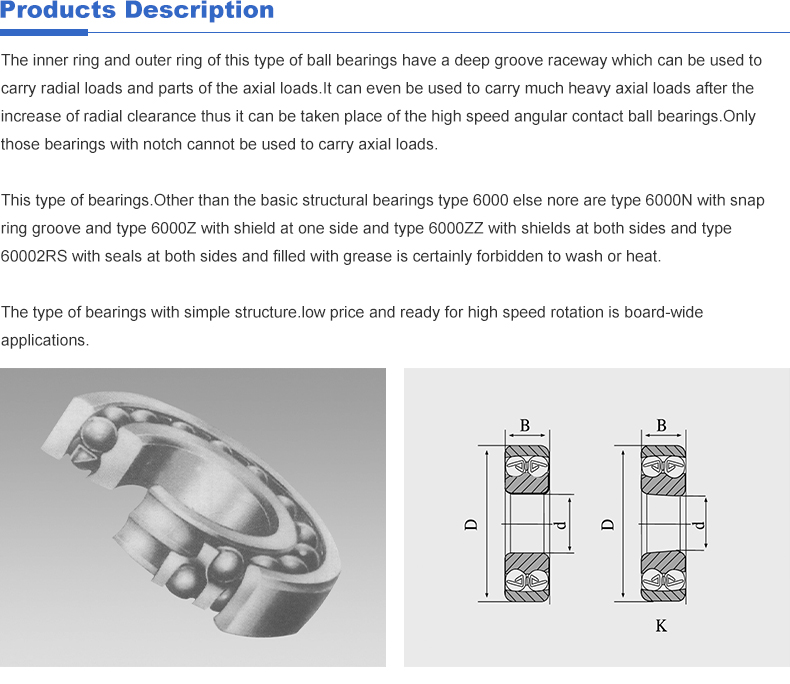
Oct . 02, 2024 00:22 Back to list
Understanding the Advantages of Four Point Contact Bearings in Machinery Applications
Understanding Four Point Contact Bearings
Four point contact bearings are a specific type of bearing designed to accommodate both radial and axial loads with exceptional performance characteristics. Unlike traditional bearings, these innovations allow for a unique arrangement that enhances operational efficiency in a range of applications.
Design and Construction
At the heart of a four point contact bearing is its unique geometrical configuration. This design features four evenly distributed contact points between the inner and outer rings, which allows for the effective support of combined loads. The inner ring typically rotates while the outer ring remains stationary, or vice versa, depending on the application. The rolling elements—usually ball bearings—are held within a cage that separates them, ensuring even distribution of load across all four points of contact.
This design differs significantly from other bearing types, such as deep groove ball bearings, where the load is supported primarily at two contact points. By utilizing four contact points, these bearings can distribute loads more evenly and handle higher stresses without sacrificing performance or durability.
Advantages of Four Point Contact Bearings
1. Load Handling The primary advantage of four point contact bearings is their ability to handle both radial and axial loads. This allows them to function effectively in environments where multi-directional loads are prevalent, such as in machinery where components are subjected to varying directional forces.
2. Space Efficiency Due to their design, four point contact bearings often require less radial space compared to other types of bearings that might need multiple components to handle the same load capacities. This can be particularly beneficial in applications with limited installation space.
four point contact bearing

3. Enhanced Stability The balanced nature of the four point contact system provides enhanced stability during operation. This stability translates to lower vibration levels and reduces wear and tear on associated machine elements, leading to a longer service life for both the bearing and the machine itself.
4. Alignment Tolerance Four point contact bearings are tolerant to misalignments. This characteristic is crucial in industrial applications where slight shifts may occur during operation, ensuring that the bearings continue to perform optimally without leading to premature failure.
Applications
Four point contact bearings are versatile and find applications across various industries. They are commonly used in
- Robotics For joint systems that require precise movement. - Machine Tools In spindles and rotating parts that align or need to withstand significant loads. - Automotive Engineering In wheel hubs and steering systems where multi-directional forces are prevalent. - Aerospace For components requiring high precision and the ability to handle significant stress.
Conclusion
In summary, four point contact bearings represent a significant advancement in bearing technology, characterized by their unique ability to manage combined loads efficiently. Their robust design, coupled with the advantages of space efficiency and enhanced stability, makes them an ideal choice for many demanding applications. As industries continue to evolve and seek out more effective engineering solutions, the importance and utilization of four point contact bearings are likely to grow, underscoring their role in modern machinery and robotic systems. Whether in manufacturing, automotive, or aerospace applications, understanding and implementing these bearings can lead to improved performance and longevity of machinery, ultimately contributing to enhanced operational efficiency.
Latest news
-
Premium Deep Groove Ball Bearings | High Speed & Reliability
NewsAug.29,2025
-
Durable Scaffolding Clamps - Secure & Reliable Tube Connectors
NewsAug.28,2025
-
Common Failures in Thrust Ball Bearings and Solutions
NewsAug.22,2025
-
How Tapered Roller Bearings Can Take Shock Loads
NewsAug.22,2025
-
Angular Bearings in High-Precision Spindles
NewsAug.22,2025
-
The Impact of Misalignment on Cylindrical Roller Bearing Performance
NewsAug.22,2025
